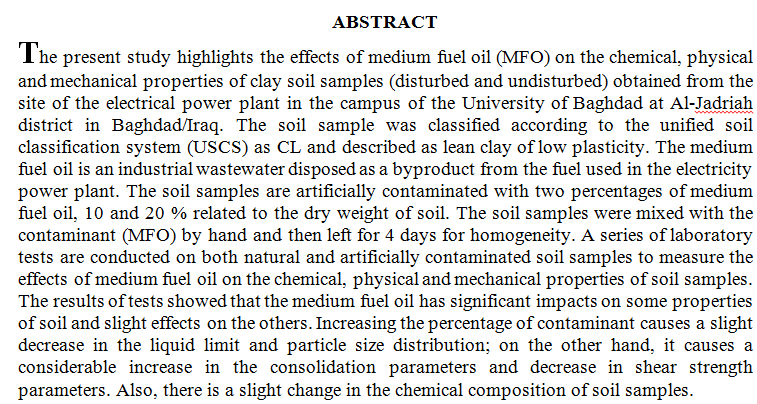
The aim of this paper is to determine the significant levels of some heavy metals such: lead, chromium, nickel and cadmium, were determined. Sources of pollution and their distribution according to presence of elements in the soils over the whole zone of the province of Maysan in southern of Iraq were investigated 36 soil samples from different zones: residential, industrial, commercial, agricultural and main roads, were collected from the soil surface and a depth of 30 cm and analyzed measuring of concentrations for heavy metals by a device ICP-MS technique. The results were compared with global standard levels of these elements in the soil.
In the early 90s military operations and United Nations Special Commission “UNSCOM” teams have been destroyed the past Iraqi chemical program. Both operations led an extensive number of scattered remnants of contaminated areas. The quantities of hazardous materials, incomplete destructed materials, and toxic chemicals were sealed in two bunkers. Deficiency of appropriate destruction technology led to spreading the contamination around the storage site. This paper aims to introduce the environmental detection of the contamination in the storage site area using geospatial analysis technique. The environmental contamination level of nutrients and major ions such as sulphate (SO4), potassium (K), sodium (Na), magnesi
... Show More (1)
(1)
 (4)
(4)
 (2)
(2)
Levan is an exopolysaccharide produced by various microorganisms and has a variety of applications. In this research, the aim was to demonstrate the biological activity of levan which produced from B. phenoliresistens KX139300. These were done via study the antioxidant, anti-inflammatory, anticancer and antileishmanial activities in vitro. The antioxidant levan was shown 80.9% activity at 1250 µg/mL concentration. The efficient anti-inflammatory activity of 88% protein inhibition was noticed with levan concentration at 35 µg/mL. The cytotoxic activity of levan at 2500 µg/mL concentration showed a maximum cytotoxic effect on L20B cell line and promastigotes of Leishmani tropica. Levan has dose-dependent anticancer and antileishman
... Show More (13)
(13)
 (11)
(11)
Levan is an exopolysaccharide produced by various microorganisms and has a variety of applications. In this research, the aim was to demonstrate the biological activity of levan which produced from B. phenoliresistens KX139300. These were done via study the antioxidant, anti-inflammatory, anticancer and antileishmanial activities in vitro. The antioxidant levan was shown 80.9% activity at 1250 µg/mL concentration. The efficient anti-inflammatory activity of 88% protein inhibition was noticed with levan concentration at 35 µg/mL. The cytotoxic activity of levan at 2500 µg/mL concentration showed a maximum cytotoxic effect on L20B cell line and promastigotes of Leishmani tropica. Levan has dose-dependent anticancer and antileishmanial acti
... Show More (14)
(14)
 (11)
(11)
This study was conducted in the field of the Poultry Research Station of the animal resources Department / office of Agricultural Research / Ministry of Agriculture from the period 4th April to16th May2021.This study was aimed to investigate the effect of using avocado and chia oil and their mixture in broiler diets on the final productive performance and meat cholesterol concentration and measuring meat oxidation indicators after storing it for 60 days. 300 one-day-old (Ross308) chicks were fed on diets that used avocado oil and chia with percentages of 0, 0.2, 0.4, 0.6%, respectively, and their mixture consisting of 0.0, 0.1, 0.2, 0.3 each of avocado and chia oil (50% avocado + 50% chia oil). The experiment included 10 treatments
... Show MoreThis study aimed to analyze and measure the relationship between oil revenues and financial sustainability in Iraq, the study used the stylistic approach inductive and deductive approach. Accompanied by the use of quantitative and analytical style, which was based on two variables oil revenues and net general budget on annual data covered the period (1990-2013). Among the most important findings of the study contain the time-series variables study on the root of the unit and is not stable in the general level, and become stable after the use of mathematical processors to gain access to a stable by taking the first difference of natural Ogartm of the series. The way (Johnson) to a long-term relationship between oil revenues and ne
... Show MoreThis research is considered one of the important researches in Maysan Governorate, as it focuses on the construction of helicopter airport project in the oil fields of the Maysan Oil Company, where the oil general companies in Maysan Governorate suffer from the cost of transporting the foreign engineering experts and the governing equipment of sustaining oil industry from Iraq's international airports to oil fields and vice versa. Private international transport companies transport foreign engineering from the oil fields to Iraqi airports and vice versa, and other international security companies take action to provide protection for foreign engineering experts during transportation. Hence, this process is very costly.
&nbs
... Show MoreThe research aims to learn spatial disparities tracts of agricultural crops in the
province of Maysan and their relationship (the salinity of the soil and the degree of chemical
interaction (PH)) The research is divided into an introduction and three Investigation eat first
section spatial disparities agricultural crops (cereals, vegetables, legumes and forage). The
comparison between the years of production in the province where the province has seen
varied spatial by hand and taking second section degrees of soil salinity and its impact on
agriculture, as well as the chemical reaction (PH) and its impact on agriculture The third
section has been used three technical techniques first linkage and the second simple an
